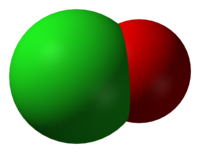Hypochlorite
 |
|
 |
|
| Names | |
|---|---|
|
IUPAC name
Hypochlorite
|
|
|
Systematic IUPAC name
chlorate(I)
|
|
| Identifiers | |
|
14380-61-1 |
|
| 3D model (Jmol) | Interactive image |
| ChEBI |
CHEBI:29222 |
| ChemSpider |
55632 |
| ECHA InfoCard | 100.235.795 |
| 682 | |
| PubChem | 61739 |
| UN number | 3212 |
|
|
|
|
|
Except where otherwise noted, data are given for materials in their standard state (at 25 °C [77 °F], 100 kPa).
|
|
|
|
|
| Infobox references | |
In chemistry, hypochlorite is an ion composed of chlorine and oxygen, with the chemical formula ClO−. It can combine with a number of counter ions to form hypochlorites, which may also be regarded as the salts of hypochlorous acid. Common examples include sodium hypochlorite (household bleach) and calcium hypochlorite (bleaching powder, swimming pool "chlorine").
Hypochlorites are frequently quite unstable in their pure forms and for this reason are normally handled as aqueous solutions. Their primary applications are as bleaching, disinfection and water treatment agents but they are also used in chemistry for chlorination and oxidation reactions.
A variety of hypochlorites can be formed by a disproportionation reaction between chlorine gas and metal hydroxides. The reaction must be performed at close to room temperature, as further oxidation will occur at higher temperatures leading to the formation of chlorates. This process is widely used for the industrial production of sodium hypochlorite (NaClO) and calcium hypochlorite (Ca(ClO)2).
Large amounts of sodium hypochlorite are also produced electrochemically via an un-separated chloralkali process. In this process brine is electrolyzed to form Cl
2 which dissociates in water to form hypochlorite. This reaction must be run in non-acidic conditions to prevent chlorine gas from bubbling out of solution:
...
Wikipedia
